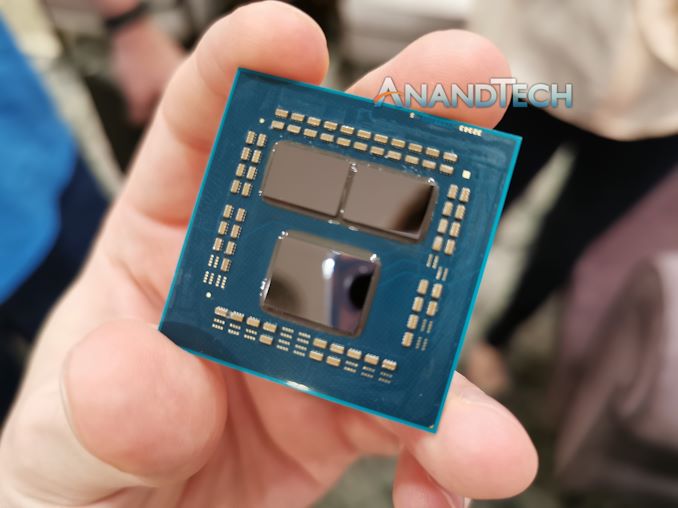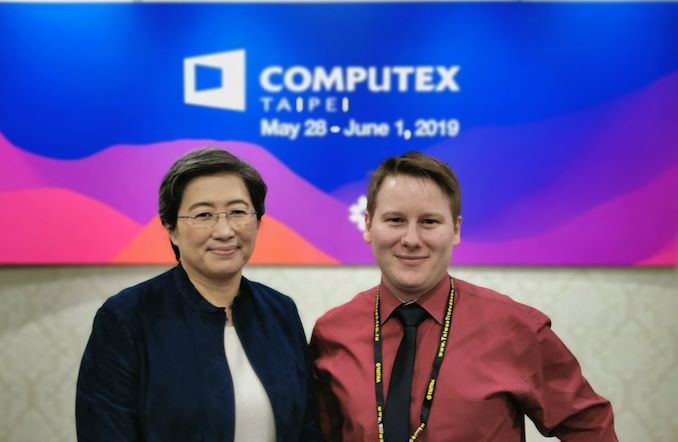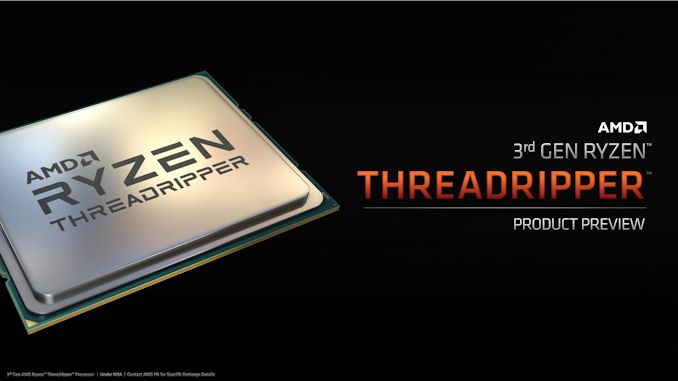AMD Q4: 16-core Ryzen 9 3950X, Threadripper Up To 32-Core 3970X, Coming November 25th
by Dr. Ian Cutress on November 7, 2019 9:00 AM EST
AMD is set to close out the year on a high note. As promised, the company will be delivering its latest 16-core Ryzen 9 3950X processor, built with two 7nm TSMC chiplets, to the consumer platform for $749. Not only this, but AMD today has lifted the covers on its next generation Threadripper platform, which includes Zen 2-based chiplets, a new socket, and an astounding 4x increase in CPU-to-chipset bandwidth.
This year AMD is presenting its ‘Fall 2019 Desktop Update’, covering the new products for the holiday season. Q4 is historically a good target for increased consumer sales, as long as the products hit the right price point and are available in volume for the peak shopping periods. We’ve been waiting mercilessly for more details about the crème-de-la-crème of what AMD has to offer with its 7nm product portfolio for both mainstream Ryzen desktop processors, but also the creator and workstation focused 3rd Gen Threadripper. After continuously requesting information from CEO Lisa Su since the middle of the year, AMD is lifting the lid on the product details, pricing, and launch dates.
The short version of today’s announcement revolves around several parts, in completely different markets.
- The Ryzen 9 3950X 16-core CPU for desktops
- Ryzen Threadripper 3rd Gen Family: Starting with the 24-core 3960X and 32-core 3970X
- New TRX40 motherboards for the new Threadripper Processors
- A new $49 Athlon 3000G for the entry level market
All of this hardware is set to come to market through the month of November at the following dates:
- Ryzen 9 3950X: Retail on November 25
- TR 3960X and TR 3970X on November 25th
- TRX40 motherboards on November 25th
- Athlon 3000G on November 19th
One key takeaway from today’s announcements is how AMD is moving the traditional desktop and high-end desktop markets. When CEO Dr. Lisa Su was asked earlier this year what will happen to Threadripper as the mainstream Ryzen family moves ‘up’ in performance, her response was that ‘Threadripper will move up-up’. To that effect, we are seeing AMD’s delineation between mainstream desktop and high-end desktop move up to between 16-core and 24-core, with room at the top for more cores if AMD wants to go that way.

Our Group Interview with Dr. Lisa Su at Computex 2019
This new hardware is also breaking new records for enthusiast CPU TDP values, as well as representing new ground on the latest 7nm process technology now available to the wider market. Details about pricing, TDP, AMD’s strategy, AMD’s performance numbers, TRX40 chipset information, and analysis of the announcements are all inside.












171 Comments
View All Comments
extide - Thursday, November 7, 2019 - link
Dependson your workloads. Both my desktop and work laptop have 64GB and I want to move my desktop at home to 128GB soon.close - Thursday, November 7, 2019 - link
I have a machine with 1024 cores and 2TB or RAM (no joke). I think the point of the comment above was that you don't *need* 64GB just because you need a TR.voodoobunny - Thursday, November 7, 2019 - link
... what do you *do*, and how can we do that too?imaheadcase - Thursday, November 7, 2019 - link
That is why these new CPUs are a slippery slope for people. At the end of the day even the hardcore gamer really has no incentive to upgrade past a CPU like the 2600K from Intel that was so popular. AMD is trying to put the "business" and "consumer" cpu in different category, but every year it seems kind of comical in most regards. Not saying that they don't have a advantage, but like you said the performance is getting to the point that you will not actually care about Mhz or core count, and more of feature sets of the CPU.Case in point:
"3.5 GHz base frequency and a 4.7 GHz single core boost frequency; the overall all-core turbo frequency will be dependent on the motherboard used, the quality of the silicon, and the turbo in play."
The last CPU i had boost was a 486dx intel cpu that went from 33mhz to 66mhz Boosted..even at that time i remember the controversy of it all. What i'm saving is when you get to a point that you have so many cores and are itching for a measly 100mhz or so its time to focus on integrating new tech into the cpu.
zmatt - Thursday, November 7, 2019 - link
Maybe your memory is foggy but the turbo on the 486 was a misnomer. It didn't make the cpu faster. 66mhz was the base clock. It halved the multiplier to run the cpu at 33mhz for games that didn't use the rtc. Many DOS games didn't support polling system time from the rtc because a lot of 386 and earlier systems didn't have them. So they kept time relative to the cpu cycles as a work around. I remember Liero did this and anything faster than a 16mhz 386 made the game actually run faster, to the point of unplayability. Unclocking the 486 via the turbo button helped, although on some games not enough.FreckledTrout - Thursday, November 7, 2019 - link
True. They all just misnamed the button turbo :) Which even back in the the 286 days I had a turbo button it of course worked as you described albeit lower frequencies.Xyler94 - Thursday, November 7, 2019 - link
There's more to a PC than raw CPU power.Platform features like PCIe version, SATA version, NVMe, some things that weren't even a sparkle in the eyes of engineers back in the Sandybridge days. Sure, if you only game, there's not too much of a difference, but there is a good one to say no to Sandybridge era CPUs in modern times. Hell, I wanna upgrade my 4790k, which is 3 years younger than Sandy Bridge.
The hardcore gamer have a lot of reasons to upgrade from Sandy, CPUs are faster, have more features, and newer stuff works better for newer OSs and such.
Threska - Thursday, November 7, 2019 - link
Instructions the earlier CPU didn't.**Reason I had to upgrade. The DRM needed it.
FreckledTrout - Thursday, November 7, 2019 - link
You have a point for the average person, CPU performance is pretty much a commodity. It took awhile but we have hit a point where people can reasonably afford more compute power than they need. However people who do real work like say video editing and don't have server farms these advances have been huge as they can never have to much compute.Spunjji - Friday, November 8, 2019 - link
This hasn't been true for around 2-3 years now, depending how you measure. Sandy had a long life (mainly thanks to its extremely conservative clock rates at stock) but it's way outside what I'd recommend to anyone looking to game even moderately seriously now.